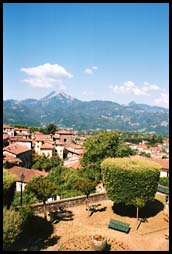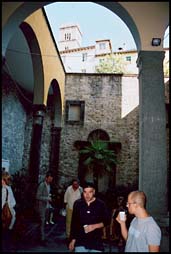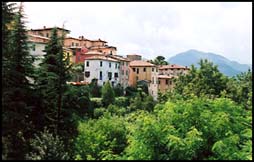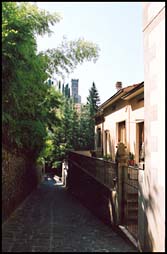Barga - Chianti, Culture and Chips
Experiencing Italy with a Scots accent in the hills of northern Tuscany
Ian R. Mitchell
 The village of Barga in northern Tuscany claims with some merit to be one of I Borghi piu belli d?Italia. Standing on a wooded hill above the valley of the Serchio River, the walled settlement with its twisting flagged streets and grand palazzi is a time capsule of centuries-ago Italy, and a more beautiful town would be hard to find. However Barga?s second claim to fame is true beyond doubt, it is certainly Il Borgho piu scozzese d'Italia, and the nearest thing Scotland has had to a colony, due to its connections with the Italian community in Scotland. This combination of Italian exoticism underlain with Scots familiarity alone would make this a unique and fascinating place for a holiday. Barga is a place which exceeds expectations, and any visit there will certainly give you more than you?d bargained for.
The village of Barga in northern Tuscany claims with some merit to be one of I Borghi piu belli d?Italia. Standing on a wooded hill above the valley of the Serchio River, the walled settlement with its twisting flagged streets and grand palazzi is a time capsule of centuries-ago Italy, and a more beautiful town would be hard to find. However Barga?s second claim to fame is true beyond doubt, it is certainly Il Borgho piu scozzese d'Italia, and the nearest thing Scotland has had to a colony, due to its connections with the Italian community in Scotland. This combination of Italian exoticism underlain with Scots familiarity alone would make this a unique and fascinating place for a holiday. Barga is a place which exceeds expectations, and any visit there will certainly give you more than you?d bargained for.
Lying in the province of Lucca, Barga has been an important place since the construction of its cathedral in the 10th. century. Coming under the dominance of first Lucca and then Florence, Barga prospered through trade and eventually became integrated into the united Italy created in 1861. However by this time its former glories had gone, and like much of Tuscany and Italy in general, Barga's main product was that of emigrants seeking to escape from the poverty associated with working small plots of land under conditions of feudal exploitation. Successful emigrants started as street traders and worked themselves up to owners of groceries, barbers' shops and restaurants, attracting fellows from their local village. Some Tuscan villages organised a trail to America, some to Argentina, but from bella Barga, as luck would have it, the trail led to Scotland. Now the wealth gained from emigrants has helped transform Barga. But the links remain; each summer the town is full of Scots-Italians on holiday, which gives it a unique flavour. "If ye get lost, jist gae tae the Geleteria and ask Wanda fur directions," I was told, "She's fae Rothesay."
 The Italians who came to Scotland brought our country great benefits, like cappuccino, spaghetti and good ice-cream, but they kept the best to themselves, as a trip to Barga will demonstrate. Many of the restaurants there belong to families who have establishments in Dumfries, or Paisley (Barga abounds with Buddies), or Bearsden, or even Inverness. But gastronomic standards here are far higher- and prices far lower, than in Scotland. This is Chianti country and as well as names of those denominazioni you will have heard of at home for a fraction of the price, most restaurants and the local alimentari sell local wines produced in small quantities, often from the booming organic wine producing sector. A house wine in one trattoria was, I was told, popular with the Glaswegians because of its 14 % alcoholic content. Wine tasting tours are available, and allow the sampling of several wines by small local producers, with the opportunities to purchase, and include a gastronomic lunch.
The Italians who came to Scotland brought our country great benefits, like cappuccino, spaghetti and good ice-cream, but they kept the best to themselves, as a trip to Barga will demonstrate. Many of the restaurants there belong to families who have establishments in Dumfries, or Paisley (Barga abounds with Buddies), or Bearsden, or even Inverness. But gastronomic standards here are far higher- and prices far lower, than in Scotland. This is Chianti country and as well as names of those denominazioni you will have heard of at home for a fraction of the price, most restaurants and the local alimentari sell local wines produced in small quantities, often from the booming organic wine producing sector. A house wine in one trattoria was, I was told, popular with the Glaswegians because of its 14 % alcoholic content. Wine tasting tours are available, and allow the sampling of several wines by small local producers, with the opportunities to purchase, and include a gastronomic lunch.
The food is superb. The hills north of Lucca produce probably the best olive oil in the world, in a bewildering array of varieties, and the woods are the source of the abundant porcini which feature in many local dishes. Buy these mushrooms in local shops and they will cost a fraction of what they will back at the airport. The woods are also full of castagni, local chestnuts which feature in many dishes and are also ground into flour for baking, producing excellent crepes and torte. Chestnut flour is also used as the basis of the local polenta which features prominently in the cooking. Other items on the menu are trout from the Serchio River, and wild boar from the woods of the hills around the village. Ice cream comes in every conceivable variety, including that made with local frutta di bosco, and most deliciously, one version that looked like it was made with peas, but which turned out to be a delicious sour-apple ice cream.
 On the terrace of the Trattoria da Riccardo, just outside the Porta Mancianella, you can sit on the terrace overlooking the mountains - and overlook the garden where the vegetable and herbs for your meal originate, an unfamiliar experience at home. But then the familiar returns. The most interesting and unique item of local gastronomy comes in the form of a tribute to a culinary tradition of the land which made the fortunes of most of the Italian emigrants to Scotland, fish and chips. For the first two weeks every August the town hosts a festival of Pesce e Patate when you can wash down your fish supper with chianti.
On the terrace of the Trattoria da Riccardo, just outside the Porta Mancianella, you can sit on the terrace overlooking the mountains - and overlook the garden where the vegetable and herbs for your meal originate, an unfamiliar experience at home. But then the familiar returns. The most interesting and unique item of local gastronomy comes in the form of a tribute to a culinary tradition of the land which made the fortunes of most of the Italian emigrants to Scotland, fish and chips. For the first two weeks every August the town hosts a festival of Pesce e Patate when you can wash down your fish supper with chianti.
For a small town, Barga buzzes. In July there takes place the festival of Barga Jazz, where local musicians perform in the open air in the evenings, and you can eat you meal al fresco to a musical accompaniment. The town has always attracted artists and writers, such as the great poet Giovanni Pascoli who made the town his home a century ago, and died there, in what he called "the land of the beautiful and the good." You can sit on the balcony at the Caffe Capretz, one of his favourite spots, and look over the flowers on the railings at the Apuane mountains. The composer Puccini was a friend of Pascoli and a regular vistor to Barga and a whole host of painters known as the Pascoli Generation found inspiration in the town, such as Cordati, Magri and Santini.
The most recent artist to be inspired by Barga is Scotland's own John Bellany. Though his house is in Garfagnana nearby, Bellany has a gallery in Barga and the town and what Bellany describes as the "enchanted landscape" around is a frequent feature in his more recent painting. Another Scottish artist at home in Barga is Glasgow based Maggie Ramage, who teaches painting at the Villa Bellavista for Artemisia Holidays. There appears to be an exhibition opening every day in Barga (on my first day I went to two), and the local galleries such as the Casa Cordati have regularly changing exhibitions. Theatre in Barga dates back centuries to when the Duke and Duchess had their own private performances, and today the Teatro dei Differenti offers exciting summer programmes. On my trip I was able to see the first modern performance of Scarlatti's opera La Caduta dei Decemviri, and regular chamber concerts are staged.
 You can resist the temptation just to be a people-watching caf? resident by going on a passagio. A short walk around Barga itself, taking in the main attractions, is the Passegiatta Panoramica, which lasts around an hour and finishes at the cathedral. This originally Romanesque building has striking marble friezes on the exterior, and inside are found a fine carved marble pulpit and Della Robbia terracottas. (Leaflets from the Tourist office). A longer walk has been designed which takes you on an old, cobbled mule track above Barga, avoiding the traffic, to the gorgeous hamlet of Sommocolonia in about an hour and a half. This gives views of Barga to die for, and is also interesting as here in 1944 a major engagement took place between the partisans and the Germans and their Italian Fascist allies, resulting in a massacre of the local inhabitants. (Again, leaflet at Tourist office.) But take provisions; there is no shop or caf? in Sommocolonia.
You can resist the temptation just to be a people-watching caf? resident by going on a passagio. A short walk around Barga itself, taking in the main attractions, is the Passegiatta Panoramica, which lasts around an hour and finishes at the cathedral. This originally Romanesque building has striking marble friezes on the exterior, and inside are found a fine carved marble pulpit and Della Robbia terracottas. (Leaflets from the Tourist office). A longer walk has been designed which takes you on an old, cobbled mule track above Barga, avoiding the traffic, to the gorgeous hamlet of Sommocolonia in about an hour and a half. This gives views of Barga to die for, and is also interesting as here in 1944 a major engagement took place between the partisans and the Germans and their Italian Fascist allies, resulting in a massacre of the local inhabitants. (Again, leaflet at Tourist office.) But take provisions; there is no shop or caf? in Sommocolonia.
For the more adventurous walker the Serchio valley lies between the crest of the Appenines where Scottish-like terrain gives you mountains rising to over 6000ft, and where Monte Giovo is a worthy objective. To the west of the Serchio valley lie the slightly lower but more rugged Alpi Apuane, whose dolomite-like ridges and summits give challenging walking, and whose Pania della Croce tantalises when seen from Barga. These mountains have good, marked paths, and Rifugi, where even if you don't stay overnight, you can buy refreshments. Sitting in the cosy Rifugio Enrico Rossi below the Pania, eating hearty bean soup and avoiding a thunderstorm, it was difficult to imagine that the hut had been the scene of a fight between partisans using it as a base in 1944, and German troops hunting them down. A memorial to those slain can be found at the beginning of the ascent of the Pania della Croce.
Near to Barga lies the village of Coreglia Antellmine, cautiously calling itself one of the most beautiful villages in Italy. It is worth visiting as it is unchanged, and must be what Barga was like 50 years ago; a couple of quiet cafes, no restaurants or artisan ware shops, and no hint of Scottish accents, indeed no evidence of tourists at all when I descended to it from the mountains. Coreglia has what must be the world's only Museum of Emigration, telling of its inhabitants who roamed the world selling plaster religious figurines. A little further away is Bangi di Lucca, with its newly - restored casino (the first in Europe), again open to vistors, and its Anglican Church associated with the likes of Shelly, Byron and the Brownings who came to this fashionable spot in the early nineteenth century. This is a gorgeous little place, almost devoid of tourists when I visited, and the bagni where one can take the waters with a steam and mud bath, had only half a dozen visitors. A delightful visit to a faded relic of a past age.
Barga bustles, but there is no tourist tat, no tourist "attractions" - indeed, very few tourists as such, no fast food outlets, no binging Brits. Just a gorgeous town with masses to offer and a people who have a Scots flavouring to their Italian extravagance. By the end of a week I knew everyone: the gallery owners, the caf? proprietors, the taxi drivers, even the guys who swept the streets. I had met a couple of fellow Scots on the slopes of Monte Giovo and was introducing them in a restaurant to my Barga hosts. At the next table was an Italian family, chatting in Italian and presided over by a formidable matriarch. Hearing my introductions the matriarch commented in an unmistakable Scottish accent, "Ye might as well introduce us aw while ye are at it."That's Barga.
Copyright I.R. Mitchell
Ian R. Mitchell. - Ian Mitchell's Walks in and around Glasgow
Accommodation in Tuscany
Benito Casci, born in Barga and resident of Glasgow for a number of years has established a business in Tuscany. http://www.housesintuscany.net. This summer we will be heading off for a holiday at one his lovely villas, just north of Lucca, at Castiglione Garfagnana.
Travel information
Our recent trip to Tuscany - Pat, June, 2005.






